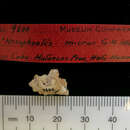en
names in breadcrumbs



Nesophontes (Jättipäästäiset) is a genus of mammals in the family nesophontid insectivores. Reproduction is viviparous. They rely on arboreal (locomotion) to move around.
EOL has data for 14 attributes, including: